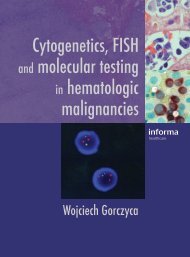Color Atlas of Hematology - Practical Microscopic and Clinical ...
Color Atlas of Hematology - Practical Microscopic and Clinical ...
Color Atlas of Hematology - Practical Microscopic and Clinical ...
- No tags were found...
Create successful ePaper yourself
Turn your PDF publications into a flip-book with our unique Google optimized e-Paper software.
176Cytology <strong>of</strong> Organ Biopsies <strong>and</strong> ExudatesReactive Lymph Node Hyperplasia <strong>and</strong>Lymphogranulomatosis (Hodgkin Disease)Reactive lymph node hyperplasia <strong>of</strong> whatever etiology is characterized by aconfused mixture <strong>of</strong> small, middle-sized, <strong>and</strong> large lymphocytes. Whenthe latter have a nuclear diameter at least three times the size <strong>of</strong> the predominatingsmall lymphocytes <strong>and</strong> have a fair width <strong>of</strong> basophilic cytoplasm,they are called immunoblasts (lymphoblasts). Cells with deeplybasophilic, eccentric cytoplasm <strong>and</strong> dense nuclei are called plasmablasts,<strong>and</strong> cells with a narrow cytoplasmic seam are centroblasts. Lymphocytescan also to varying degrees show a tendency to appear as plasma cells, e.g.,as plasmacytoid lymphocytes with a relatively wide seam <strong>of</strong> cytoplasm.Monocytes <strong>and</strong> phagocytic macrophages are also seen (Fig. 63).Table 30 (p. 178) summarizes the different forms <strong>of</strong> reactive lymphadenitis.The basic cytological findings in all <strong>of</strong> them is always a completemixture <strong>of</strong> small to very large lymphocytes. Occasionally more specificfindings may indicate the possibility <strong>of</strong> mononucleosis (increased immaturemonocytes) or toxoplasmosis (plasmablasts, phagocytic macrophages,<strong>and</strong> possibly epithelioid cells).Any enlargement <strong>of</strong> the lymph nodes that persists for more than twoweeks should be subjected to histological analysis unless the history, clinicalfindings, serology, or CBC <strong>of</strong>fer an explanation.At first sight, the confusion visible in the cytological findings <strong>of</strong> lymphogranulomatosis(Hodgkin disease) is reminiscent <strong>of</strong> the picture in reactivehyperplasia (something which may be important for an underst<strong>and</strong>ing <strong>of</strong>the pathology <strong>of</strong> this disease compared with other malignant neoplasms).However, some cells elements show signs <strong>of</strong> a strong immunological“over-reaction” in which large, immunoblast-like cells form with welldevelopednucleoli (Hodgkin cells). Sporadically, some <strong>of</strong> these cells arefound to be multinucleated (Reed–Sternberg giant cells); infiltrations <strong>of</strong>eosinophils <strong>and</strong> plasma cells may also be found. Findings <strong>of</strong> this type alwaysrequire histological analysis, which can distinguish between fourprognostically relevant histological subtypes. In addition to this, the verylack <strong>of</strong> a clear demarcation between Hodgkin disease <strong>and</strong> reactive conditionsis reason enough to conduct a histological study <strong>of</strong> every lymph nodethat appears reactive if does not regress completely within two weeks.In cases <strong>of</strong> histologically verified Hodgkin disease, cytological analysisis especially useful in the assessment <strong>of</strong> new lymphomas after therapy.






